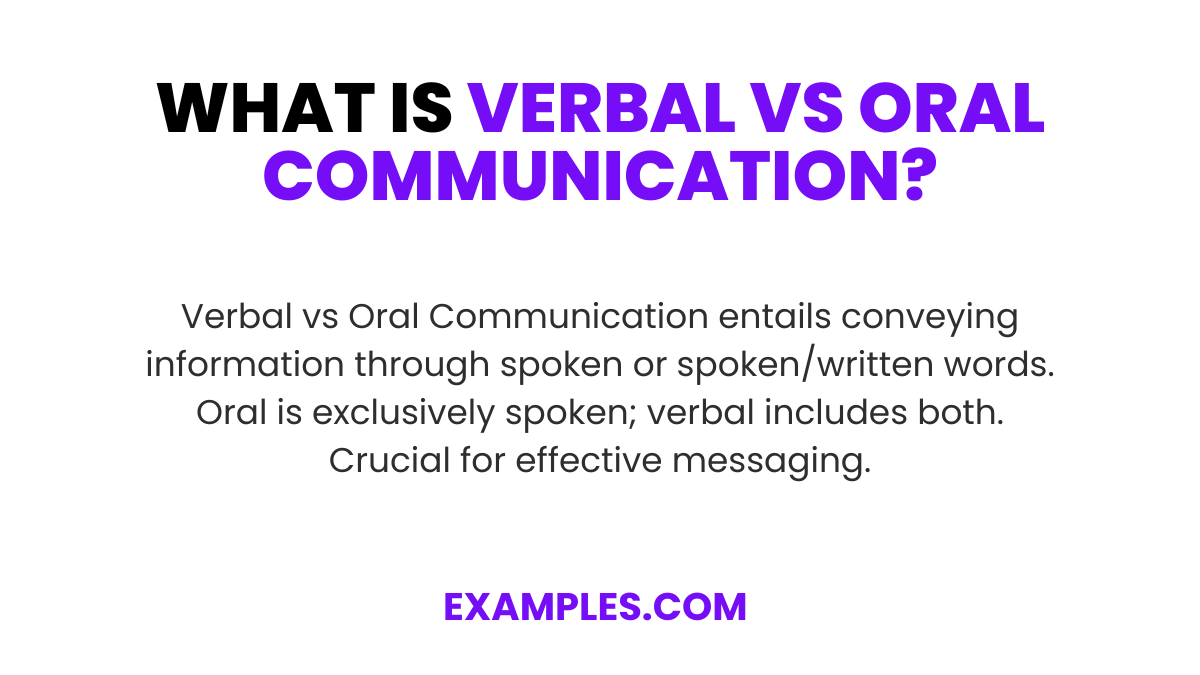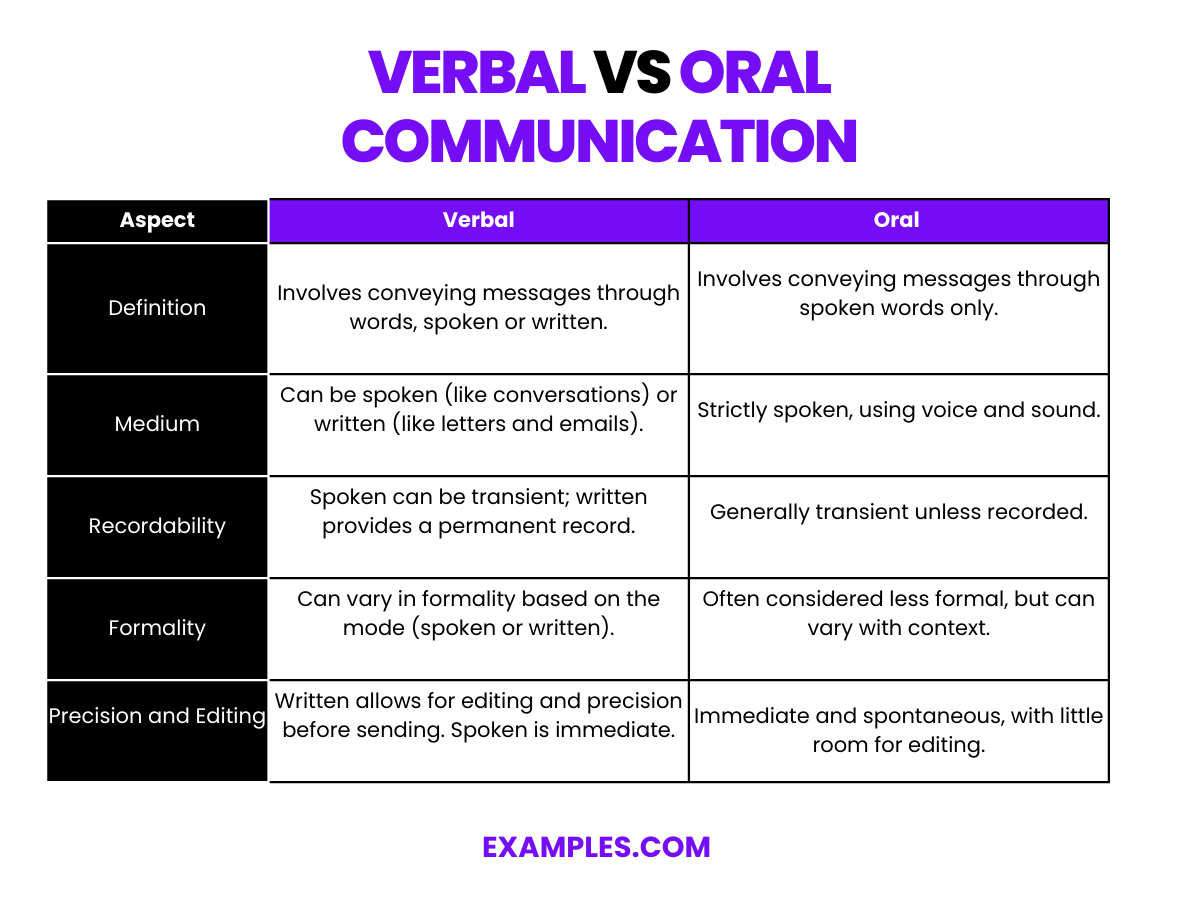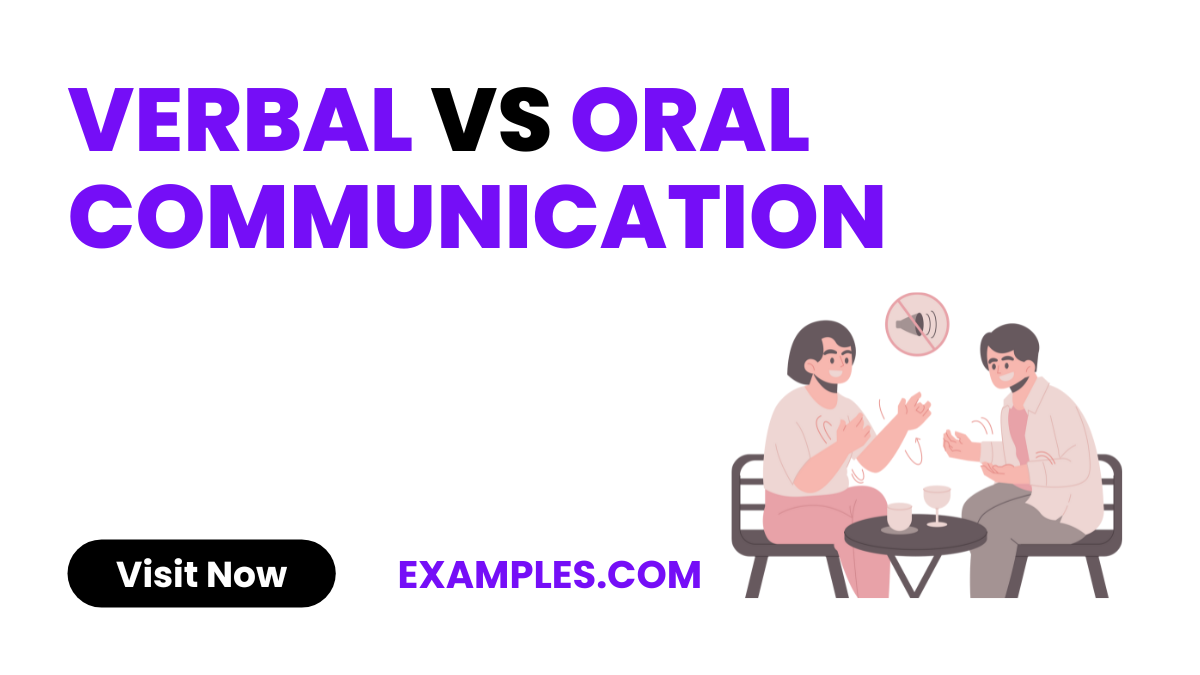Verbal vs Oral Communication – 9+ Examples
Dive into our comprehensive guide on Verbal vs Oral Communication. This guide illuminates the subtle nuances and distinct characteristics separating these two forms of expression. Through practical Communication Examples, understand how each method operates across different scenarios and their impact on personal and professional interactions. Enhance your communicative approach and embrace the power of words and speech.
Download Verbal vs Oral Communication Examples PDF
What is Verbal vs Oral Communication? – Meaning

Verbal vs Oral Communication refers to the exchange of information and ideas through spoken words (oral) or both spoken and written words (verbal). While all oral communication is verbal, not all verbal communication is oral. Verbal Communication Examples include both speaking face-to-face and writing an email. Oral communication is speaking words aloud, typically in a conversation. Understanding these differences is crucial for selecting the most effective way to convey your message.
Difference Between Verbal vs Oral Communication

The primary distinction in Verbal vs Oral Communication lies in the form of expression. Oral communication exclusively refers to spoken content, heavily reliant on What Percent of Communication is Verbal? Verbal encompasses both spoken and written mediums. Understanding Verbal Communication Techniques and the Advantages and Disadvantages of Verbal Communication is key, as each form serves different Functions of Verbal Communication in various contexts.
| Aspect | Verbal Communication | Oral Communication |
|---|---|---|
| Definition | Involves conveying messages through words, spoken or written. | Involves conveying messages through spoken words only. |
| Medium | Can be spoken (like conversations) or written (like letters and emails). | Strictly spoken, using voice and sound. |
| Recordability | Spoken can be transient; written provides a permanent record. | Generally transient unless recorded. |
| Formality | Can vary in formality based on the mode (spoken or written). | Often considered less formal, but can vary with context. |
| Precision and Editing | Written allows for editing and precision before sending. Spoken is immediate. | Immediate and spontaneous, with little room for editing. |
| Context and Usage | Broad usage in both personal and professional spheres. | Primarily used in personal conversations or informal discussions. |
| Non-Verbal Elements | In spoken form, it can include non-verbal elements. Written relies on text alone. | Accompanied by non-verbal cues like tone, facial expressions, and gestures. |
| Skill Set | Requires a diverse skill set, including writing and speaking effectively. | Focuses primarily on clear articulation, tone, and immediate feedback. |
10 Verbal Communication Examples
Verbal communication is an integral part of human interaction that encompasses various Types of Verbal Communication. It’s crucial in expressing ideas, emotions, and instructions effectively. Enhancing Verbal Communication Skills can lead to better relationships and success, especially in professional settings like Verbal Communication in the Workplace. Recognizing and practicing different forms can significantly improve your ability to convey messages clearly. Here are 10 examples of verbal communication, along with what typically causes issues and how to fix them:
- One-on-One Conversations: Face-to-face discussions are a primary form of verbal communication.
Cause: Misunderstandings can arise from unclear speech or distractions. Fix: Focus on clear articulation and active listening. - Group Discussions: Involves multiple people sharing ideas.
Cause: Can become chaotic without clear turn-taking. Fix: Implement and respect speaking turns and actively listen. - Public Speaking: Delivering a speech to an audience.
Cause: Nervousness or lack of preparation can hinder message delivery. Fix: Prepare thoroughly and practice public speaking techniques. - Meetings: Formal gatherings in workplaces to discuss agendas.
Cause: Lack of clear agenda or dominant speakers can sidetrack discussions. Fix: Set a clear agenda and ensure equal participation. - Phone Calls: Conversations where participants can’t see each other.
Cause: Lack of visual cues can lead to misunderstandings. Fix: Use clear, concise language and confirm understanding. - Video Calls: Digital meetings where participants can both see and hear each other.
Cause: Technical issues can disrupt communication. Fix: Ensure good connectivity and use visual aids if necessary. - Interviews: A formal conversation typically between an employer and a job applicant.
Cause: Stress or lack of preparation can affect clarity and confidence. Fix: Prepare responses and understand the job role and company. - Teaching: Instructors conveying information to students.
Cause: Ineffective teaching methods or lack of engagement can hinder learning. Fix: Use interactive methods and continuously engage students. - Negotiations: Discussions aimed at reaching an agreement.
Cause: Emotions or unclear terms can complicate discussions. Fix: Stay calm, clear, and focused on objectives. - Presentations: Information is delivered to an audience, often supported by visuals.
Cause: Poorly organized content or delivery can confuse the audience. Fix: Structure content clearly and practice delivery.
10 Oral Communication Examples
Dive into the dynamic world of oral communication with our in-depth guide. Explore 10 unique scenarios spanning various sectors, including Verbal Communication in Healthcare, Verbal Communication in Business, Teaching, Student Interactions, and Law Enforcement. Each example is a testament to the power and pitfalls of oral communication, offering insights into common communicative challenges and actionable strategies to enhance clarity and effectiveness. Enhance your understanding and skills in articulating ideas with precision and empathy across diverse settings.
- Patient Consultation in Healthcare: Misunderstanding medical instructions due to technical jargon.
- Cause: Overuse of medical terminology.
- Fix: Use simple language and confirm understanding.
- Negotiating a Business Deal: Misinterpretation of contractual terms leading to conflict.
- Cause: Ambiguous language or assumptions.
- Fix: Clarify terms with precise language and examples.
- Teacher Explaining Complex Concepts: Students confused by overly complex explanations.
- Cause: Not adapting to the students’ knowledge level.
- Fix: Break down concepts and check for understanding.
- Student Group Discussions: Dominating conversations without listening.
- Cause: Lack of active listening skills.
- Fix: Encourage turn-taking and active listening exercises.
- Police Interrogation: Miscommunication leading to false assumptions.
- Cause: High tension and unclear questioning.
- Fix: Use clear, direct questions and remain calm.
- Medical Team Coordination: Errors in patient care due to miscommunication.
- Cause: Stressful environment and unclear directives.
- Fix: Standardize communication protocols and confirm messages.
- Business Presentation: Losing audience interest with a monotonous delivery.
- Cause: Lack of engagement or monotone voice.
- Fix: Use varied tone and interactive elements.
- Teacher’s Feedback to Students: Students feeling demotivated by negative feedback.
- Cause: Focus on weaknesses without recognizing strengths.
- Fix: Balance criticism with positive reinforcement.
- Law Enforcement Directing Traffic: Confusion and accidents due to unclear signals.
- Cause: Non-standard gestures or rapid instructions.
- Fix: Use universally recognized signals and concise commands.
- Student Asking Questions: Hesitation to ask for clarification leading to gaps in learning.
- Cause: Fear of judgment or not wanting to interrupt.
- Fix: Foster a supportive environment that encourages questions.
Comparison between Verbal vs Oral Communication
When discussing communication, the terms “verbal” and “oral” are often used interchangeably, but they have distinct meanings that affect how we understand and engage in the exchange of information.
Verbal Communication refers to the use of words to convey a message. It encompasses both spoken and written forms of communication, making it a critical skill for everyone from Verbal Communication for Teachers to Verbal Communication for Students. This means that whether you are giving a speech (oral communication) or writing an email (written communication), you are engaged in verbal communication. Verbal communication is about the content, the choice of words, and the structure of sentences used to convey meaning.
Oral Communication, on the other hand, specifically refers to the spoken words in the communication process. It includes face-to-face conversations, speeches, telephonic conversations, video, radio, television, and voice over internet. In oral communication, the message is transmitted through the spoken words. Here the vocal tone, the pitch, and the speed of speaking also play a significant role in conveying the message. It’s particularly relevant in fields such as Verbal Communication in Law Enforcement where the clarity, tone, and immediacy of spoken word can be crucial.
- Medium and Sensory Channel:
- Verbal communication can be both written and spoken, serving a broad audience from Verbal Communication for Autism where communication needs might be specialized, to general student and teacher interactions.
- Oral communication is strictly limited to spoken words and can be heard and interpreted with immediate feedback.
- Permanence:
- Written verbal communication offers permanence and is easy to record and reference, a useful tool in educational settings for Verbal Communication for Teachers and students.
- Oral communication is transient and can be easily forgotten or misremembered if not recorded, an aspect critical in law enforcement communications.
- Feedback:
- Oral communication often has immediate feedback, a necessary part of effective Verbal Communication in Law Enforcement.
- Written verbal communication might not offer immediate feedback but allows time for thoughtful response.
- Formality:
- Written communication is often more formal and structured, important in professional or academic settings for both teachers and students.
- Oral communication can be formal or informal, and often includes informal cues such as tone and body language, crucial in understanding and teaching Verbal Communication for Autism.
- Precision and Misinterpretation:
- Written communication allows for precision, editing, and clarity, advantageous for students and teachers alike.
- Oral communication might result in immediate misunderstandings that can be instantly clarified or lead to rapid misinterpretation, a factor to consider in law enforcement scenarios.
- Convenience and Reach:
- Oral communication is often more convenient for quick, direct interaction, essential in classroom settings and on-the-field law enforcement communication.
- Verbal communication, particularly written, can reach a larger audience and can be disseminated quickly with the aid of technology, beneficial for widespread educational materials and directives in law enforcement.
Relationship between Verbal and Oral Communication
The relationship between verbal and oral communication is nuanced and integral to understanding human interaction. Recognizing their interdependence and unique features helps individuals and organizations tailor their communication strategies for maximum clarity, efficiency, and impact, especially when considering Verbal vs Written Communication. Both are subsets of communication but each serves its unique purpose and context.
Verbal Communication is a broad category that includes any form of communication involving words. It’s the cornerstone of expressing thoughts, ideas, and emotions. Whether the communication takes place in written form like books, emails, and reports, or in spoken form like conversations, speeches, and announcements, it falls under the umbrella of verbal communication. This encompasses a wide array of interactions across various fields and is fundamental in settings requiring detailed, precise, and extensive dissemination of information, particularly notable in Verbal Communication for School settings.
Oral Communication is specifically concerned with spoken words. It’s a subset of verbal communication and is characterized by the immediacy and personalization of spoken interaction. Oral communication is vital in situations where quick feedback is necessary or where the personal touch of voice, tone, and emotion can make a significant difference. It’s predominant in everyday conversations, discussions, debates, oral presentations, and scenarios requiring immediate decision-making.
- Inclusivity vs. Specificity:
- Verbal communication includes all forms of communication using words, making it a more inclusive category. Understanding the Importance of Verbal Communication is essential in fully grasping its breadth and depth.
- Oral communication is specifically about spoken words, making it a more specific category within verbal communication.
- Form and Function:
- Verbal communication serves various functions from recording history in written form to giving verbal instructions. It’s flexible and adaptable to many contexts, highlighting the Rules of Verbal Communication.
- Oral communication’s primary function is in real-time interaction, offering a personal and direct form of communication. It’s often used in conversational settings, public speaking, and anywhere immediate response is advantageous.
- Interdependence:
- Oral communication skills are part of broader Verbal Communication Skills. To effectively engage in oral communication, one must have a command of language and structure, which are part of verbal communication. This speaks to Why you need Verbal Communication Skills and how they can be enhanced.
- Verbal communication often relies on the principles and practices of effective oral communication and Ways to Improve Verbal Communication Skills, such as clarity, conciseness, tone, and engagement, especially in spoken form.
- Skill Development:
- Developing Verbal Communication Skills encompasses a wide range of abilities including writing, reading, speaking, and listening. Each skill enhances the overall ability to communicate effectively, illustrating How to Improve Verbal Communication Skills.
- Improving oral communication specifically focuses on aspects such as articulation, pronunciation, voice modulation, and quick thinking. These skills directly impact the effectiveness of face-to-face and telephonic conversations.
In conclusion, the comparison between verbal and oral communication reveals their distinct characteristics. Verbal communication emphasizes spoken words, while oral communication involves spoken words and may include written components. Understanding their effects and recognizing signs of communication breakdowns is crucial. To improve both, fostering active listening, enhancing nonverbal cues, and adapting to the context are essential steps towards effective interpersonal interactions.



